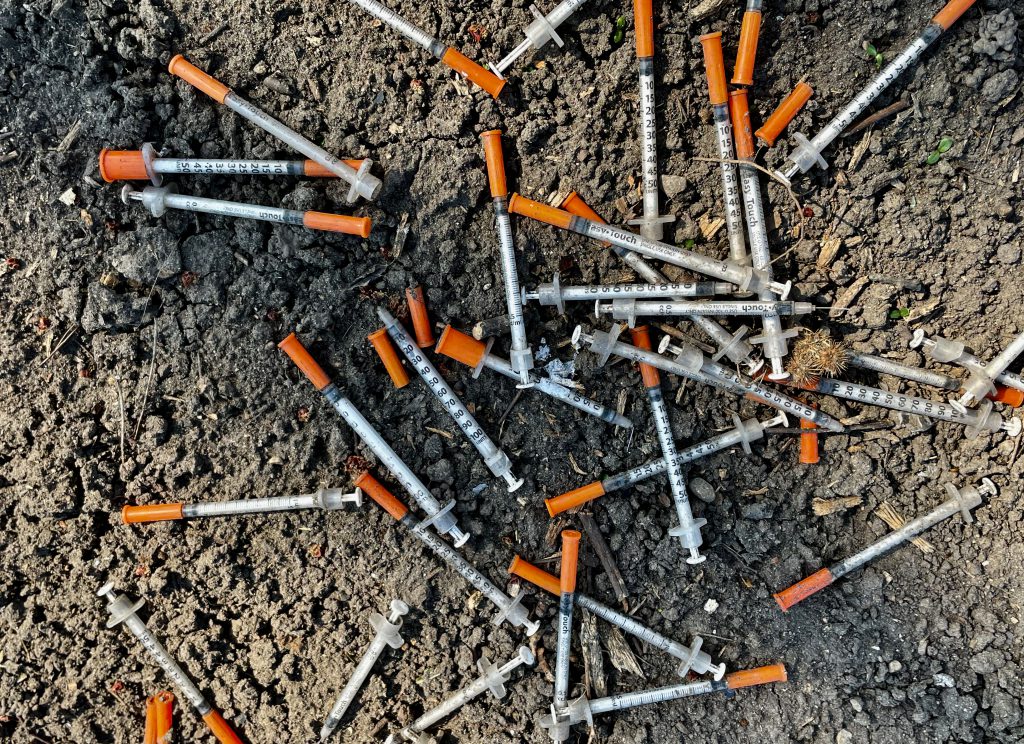Black Drug Overdose Death Rate Spikes
Deaths in county up in 2021, but up the most for African Americans.

For African Americans, this year’s numbers represent a sharp increase in percentage of overall deaths, although it has been trending up for several years. Photo by Adam Carr/NNS.
The number of African Americans who die from drug overdoses in Milwaukee County continues to rise, with Black residents making up 45 percent of this year’s fatalities, according to the Medical Examiner’s Office.
This compares to 43 percent for whites, 6 percent for Hispanics, and 3 percent for Native Americans. Last year, whites represented 59 percent of all drug overdose deaths in the county, compared with 28 percent for Blacks.
Overall, there were 113 confirmed drug overdose deaths in the county in 2021, with 93 cases pending through May 13, according to data provided by Karen Domagalski, operations manager for the Milwaukee County Medical Examiner’s Office. At the current pace, we could experience a record high of 560 drug overdose deaths this year, Domagalski said. This would surpass previous record highs of 545 in 2020 and 418 in 2019.
A steep rise in 2021
For African Americans, this year’s numbers represent a sharp increase in the percentage of overall deaths, although it has been trending up for several years. In 2019, 27 percent of individuals who died from drug overdoses in Milwaukee County were African American, up slightly from 26.5 percent in 2018 and 22 percent in 2017. Those percentages equate to 89 victims in 2017, 102 in 2018, 113 in 2019, 153 last year, and 51 so far this year, with many cases still pending through mid-May.
“It’s extremely heartbreaking,” she said. “It started hitting closer to home with the opioids and people still don’t talk about it.”
Smith said part of the problem is the stigma in some parts of the Black community about mental illness and hard drug use as well as a lack of education on opiates. Smith conducts street outreach in high drug traffic areas and said that many of the people she talks to don’t even know how Narcan, which is used to reverse the effects of an opioid overdose, works.

The number of African Americans who died of drug overdoses in Milwaukee County has increased each year since 2016. Graphic by Dwayne Burtin/NNS.
“They thought it was a needle, but it’s a nasal spray. The lack of education some of our communities have about [opioids] is astonishing to me,” Smith said.
Ald. Khalif Rainey, a member of the City-County Heroin, Opioid and Cocaine Task Force who also represents parts of the 53206 ZIP code and other areas of the North Side on the Common Council, said often when he hears from residents about drugs, it’s about rolling drug houses. Few of those conversations are about drug use and drug addiction, he said.
Rainey thinks outreach on opioids needs to be more specific to the African American population to raise awareness.
“On social media, young people are talking about perc 30s (30 milligram Percocets) and lean (codeine and soda) and other drugs that are influenced by the culture, by music,” he said. “What [types of drugs] are we doing and how can we be more specific to address that?”
Rainey said cocaine has also factored into the increase of drug overdose deaths among African Americans, mostly because that drug and many others are being cut with fentanyl, a synthetic opioid that can kill in trace amounts. In fact, 76 percent of fatal drug overdoses among African Americans involved fentanyl. These findings align with national trends.
National reports on drug overdoses
A recent brief from the National Institute of Health Care Management, citing Centers for Disease Control and Prevention data, found that an increasing number of fatal drug overdoses involved stimulants such as cocaine, many times in combination with fentanyl.
In addition, a 2020 report issued by the Substance Abuse and Mental Health Services Administration’s Office of Behavioral Health Equity, foreshadowed the situation in Milwaukee. The report states that the focus on the opioid epidemic mainly centered on white suburban and rural communities, but that Black communities were experiencing dramatic increases in drug overdose deaths.
As far back as 2017, Blacks had the highest percentages of opioid-related overdose deaths and total drug deaths attributed to synthetic opioids when compared with other groups, according to the report. The report cited stigma around drug addiction, fear of legal consequences and unequal access to treatment as factors in the increase.
Smith agrees, saying people in African American communities are scared to ask for help. She said treatment options in Milwaukee are limited and that individuals are wary of law enforcement, which prevents them from accessing resources such as Narcan and methadone.
“There is fear that our community has when it comes to law enforcement,” Smith said. “One of the barriers in our population is to let them know that Narcan boxes aren’t police monitored.”
An unrelenting pace
So far this year the majority of the victims, 72 percent, were male, and 75 percent of all deaths involved fentanyl. In terms of age, 43 percent of white victims were from the ages of 30 to 39, while 63 percent of Black victims were ages 50 and older. The 53204 ZIP code area on the South Side has lost the most residents, 10, to drug overdoses this year, while 53212 and 53208 both lost eight. The 53209 ZIP code area lost six residents, while 53206 lost four.
Sara Schreiber, forensic technical director of the county’s toxicology lab, said the majority of deaths this year have involved multiple drugs, which, in addition to the lab’s caseload, is a reason why so many cases are still pending.
“The number of substances is always increasing, and we have to determine whether or not they were involved in the death,” she said.
Task force finally meets
The City-County Heroin, Opioid, and Cocaine Task Force met for the first time in 15 months on May 5. The group received updates on several local efforts to stem drug overdose deaths, including the Vivitrol Program at the House of Corrections. Vivitrol, an injection drug used to treat heroin and opiate addictions, is being provided to some inmates at the House of Corrections before and upon their release.
Ald. Michael Murphy, chairman of the task force, said his group continues to work to secure additional resources to combat issues related to drug overdoses. He said the city’s budget “allocated very little money to the issue.”
In addition, he said the increase of drug overdose deaths among African Americans means more outreach needs to be targeted.
“In this case, I think we need to recognize that a message from one group may not always be resonating with other groups,” Murphy said. “We have to look very carefully how the best messaging would look going forward.”
Help can’t come soon enough for Smith, who said she and her team will work with anyone who comes through their doors.
“We’ll do whatever I can do to assist and get you where you need to go, no questions asked,” she said.
She’s also asking friends and loved ones to watch out for the warning signs of drug abuse, such as missing work and important events, struggles with money and changes in behavior.
Rainey wants the African American community to start talking more about drug addiction and the dangers of opiates.
“If we’re thinking it’s not our problem, then we’re not addressing it and more lives will be lost.”
Where you can get help
Drug treatment services in the Milwaukee area are available at the Gateway to Change, 10th Street Comprehensive Treatment Center, Rogers Behavioral Health, West Milwaukee Comprehensive Treatment Center, First Step Community Recovery Center, Meta House, West Allis Community Medical Services, United Community Center and other locations.
This story was originally published by Milwaukee Neighborhood News Service, where you can find other stories reporting on fifteen city neighborhoods in Milwaukee.
More about the Opioid Crisis
- Attorney General Kaul Announces Consent Judgment with Kroger Over Opioid Crisis - Wisconsin Department of Justice - Mar 21st, 2025
- Baldwin Votes to Strengthen Penalties, Step Up Enforcement Around Deadly Fentanyl - U.S. Sen. Tammy Baldwin - Mar 17th, 2025
- Wisconsin Communities Get Millions From Opioid Settlement as Deaths Decline - Evan Casey - Mar 1st, 2025
- MKE County: County Creates Easy Public Access To Overdose Data - Graham Kilmer - Feb 18th, 2025
- Milwaukee County Executive David Crowley and the Office of Emergency Management Launch New Overdose Dashboard - County Executive David Crowley - Feb 18th, 2025
- Fitzgerald Advances Legislation to Fight Opioid Epidemic - U.S. Rep. Scott Fitzgerald - Feb 6th, 2025
- Milwaukee Is Losing a Generation of Black Men To Drug Crisis - Edgar Mendez and Devin Blake - Jan 31st, 2025
- Milwaukee County’s Overdose Deaths Declined For Second Straight Year - Evan Casey - Jan 27th, 2025
- MKE County: United Community Center Awarded Drug Company Money For Addiction Treatment - Graham Kilmer - Jan 12th, 2025
- DHS Provides Update on Distribution of Latest Opioid Settlement Funds - Wisconsin Department of Health Services - Jan 9th, 2025
Read more about Opioid Crisis here
Political Contributions Tracker
Displaying political contributions between people mentioned in this story. Learn more.





















